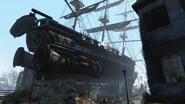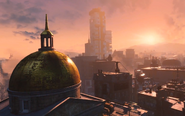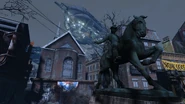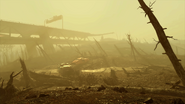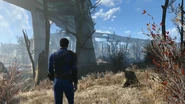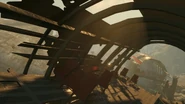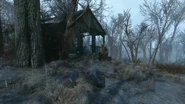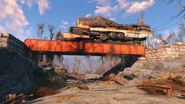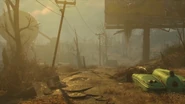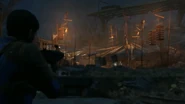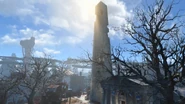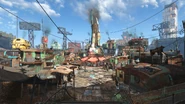Sem resumo de edição Etiqueta: sourceedit |
Sem resumo de edição Etiqueta: sourceedit |
||
| Linha 10: | Linha 10: | ||
}}{{Games|FO3|FO3TP|FO3BS|FO3PL|FO4|FO4AUT|FO4FH|FO4VW|FO4NW}}{{Traduzindo}} |
}}{{Games|FO3|FO3TP|FO3BS|FO3PL|FO4|FO4AUT|FO4FH|FO4VW|FO4NW}}{{Traduzindo}} |
||
| − | {{Quotation| |
+ | {{Quotation|A Comunidade em si nada mais é do que um antro de violência e desespero. Dentro do ambiente selado do [[O Instituto (localidade)|Instituto]], entretanto... mas os assuntos do Instituto não são da [[Lone Wanderer|sua]] conta. Sua mente sub-desenvolvida não conseguiria compreender o que nós conseguimos.|[[Zimmer|Dr. Zimmer]]|''[[Fallout 3]]''|sound=Fo3 Zimmer CommonwealthItself.ogg}} |
| − | ''' |
+ | '''A Comunidade''' (ocasionalmente chamada de '''ermos da comunidade''') foi a divisão administrativa da Nova Inglaterra, mas precisamente no estado de Massachusetts.<ref name="Emil">[http://www.1up.com/do/feature?pager.offset=1&cId=3172024 Entrevista com Emil Pagliarulo para a 1up]</ref> É chamada tradicionalmente de Comunidade, Massachusetts também fazia parte da [[New England Commonwealth]]. Depois de aniquilação atômica total, toda a Comunidade foi reduzida a "um antro de violência e desespero", como a maioria do território americano. |
| + | A comunidade era onde a localização de muitas grandes cidades, como [[Boston]], e lar da misteriosa organização do pós-Guerra conhecida como [[O Instituto|Instituto]]. |
||
| − | The Commonwealth was the location of major pre-War cities such as [[Boston]], and home to the mysterious post-War organization known only as the [[The Institute|Institute]]. |
||
| − | == |
+ | ==Visão-geral== |
| − | === |
+ | ===Pré-Guerra=== |
| − | + | A Comunidade foi a localidade de muitas batalhas entre o Reino Unido e os Estados Unidos durante a [[Guerra de Independência Americana]]—lutada entre 19 de Abril, 1775 até 3 de Setembro, 1783— quando as Treze Colônias britânicas se rebelaram contra impostos e por representação política. Nos anos que se seguiram, a guerra seria celebrada com monumentos para batalhas históricas, figuras e eventos como o monumento da Batalha de [[Bunker Hill]], a [[Monumento Paul Revere|estátua]] de Paul Revere fora de [[Old North Church]], e em museus como o [[Museu da Liberdade]]. |
|
| + | {{Traduzindo até aqui}} |
||
| − | |||
| + | Em 1969,<ref>Placa na [[Massachusetts State House]] em Fallout 4 defina 1969 como data de formação das "Treze Comunidades"</ref> a Comunidade seria intrigada sob a [[New England Commonwealth]], um novo, intermediário nível de governo criado para cooperação melhor entre os estados com interesses regionais compatíveis. |
||
| − | + | with comparable regional interests. Leading up to the eventual downfall of the United States during the [[Great War]], the Commonwealth became a major staging point for military aircraft.<ref>Proctor [[Ingram]] mentions that the Commonwealth became a major military staging point for aircraft prior to the Great War.</ref> Additionally, it would serve as the development ground for the [[Fat Man (Fallout 4)|Fat Man]] portable nuclear launcher and the testing ground for the Army Corps of Engineer's [[T-51b power armor]] at [[Fort Strong]]. The [[Defense Intelligence Agency]] would maintain a secret facility known as the [[Switchboard]], while military outposts such as [[USAF Satellite Station Olivia]] and the [[National Guard training yard]] would also dot the landscape. |
|
As world tension flared and the worldwide energy crisis erupted into the [[Resource Wars]], the Commonwealth would experience an increased military presence as the threat of Chinese infiltration and nuclear war drew closer. Various military checkpoints were established to prevent possible Chinese espionage from entering Boston and major U.S. Army installations, such as at [[Sentinel site|Sentinel Site Prescott]]—a munitions stockpile, development facility, and ICBM launch site. Echo Company of the 104th Infantry Regiment would subsequently be deployed to man the [[South Boston Military Checkpoint]], where on August 1st, 2077 orders from the Department of the Army demanded that all vehicles passing through would be stopped and given a full inspection. While the inspections purported to detain 'suspicious elements,' they arbitrarily discriminated against those of Chinese origin,<ref>[[South Boston military checkpoint terminal entries]]</ref> many of whom were already located in Chinese internment camps.<ref>[[Internment orders]] in Fallout 3 and the VDSG. Catalogue No.7320 in Fallout 4 mentions how Chinese were held at internment camps prior to the Great War.</ref> Financial reports from this time indicated that increased military spending was coupled with a reduction to healthcare, utilities and public transportation.<ref name="MSH Terminal">[[Massachusetts State House terminal entries]]</ref> Combined with rising energy costs as a result of the Resource Wars, along with hyperinflation and war weariness gripping the country, especially after the 2076 annexation of Canada—which in reality began in 2067—public order became a serious issue, especially after images of U.S. atrocities were made public. [[Governor Graham|Lieutenant Governor Graham]] would eventually place Boston under martial law,<ref name="MSH Terminal" /> while American units serving in China and on the [[Battle of Anchorage|Anchorage Front Line]] found themselves pulled back to deal with domestic unrest at home. |
As world tension flared and the worldwide energy crisis erupted into the [[Resource Wars]], the Commonwealth would experience an increased military presence as the threat of Chinese infiltration and nuclear war drew closer. Various military checkpoints were established to prevent possible Chinese espionage from entering Boston and major U.S. Army installations, such as at [[Sentinel site|Sentinel Site Prescott]]—a munitions stockpile, development facility, and ICBM launch site. Echo Company of the 104th Infantry Regiment would subsequently be deployed to man the [[South Boston Military Checkpoint]], where on August 1st, 2077 orders from the Department of the Army demanded that all vehicles passing through would be stopped and given a full inspection. While the inspections purported to detain 'suspicious elements,' they arbitrarily discriminated against those of Chinese origin,<ref>[[South Boston military checkpoint terminal entries]]</ref> many of whom were already located in Chinese internment camps.<ref>[[Internment orders]] in Fallout 3 and the VDSG. Catalogue No.7320 in Fallout 4 mentions how Chinese were held at internment camps prior to the Great War.</ref> Financial reports from this time indicated that increased military spending was coupled with a reduction to healthcare, utilities and public transportation.<ref name="MSH Terminal">[[Massachusetts State House terminal entries]]</ref> Combined with rising energy costs as a result of the Resource Wars, along with hyperinflation and war weariness gripping the country, especially after the 2076 annexation of Canada—which in reality began in 2067—public order became a serious issue, especially after images of U.S. atrocities were made public. [[Governor Graham|Lieutenant Governor Graham]] would eventually place Boston under martial law,<ref name="MSH Terminal" /> while American units serving in China and on the [[Battle of Anchorage|Anchorage Front Line]] found themselves pulled back to deal with domestic unrest at home. |
||
Edição das 13h02min de 24 de agosto de 2017
| Esta página é sobre a localidade em Fallout 4. Para as 13 comunidades americanas do pré-guerra, veja Estados Unidos. Para Organizção europeia de nações, veja Comunidade Europeia. |
Traduzindo...
Este artigo está em processo de tradução. Você pode contribuir editando ele.
|
A Comunidade em si nada mais é do que um antro de violência e desespero. Dentro do ambiente selado do Instituto, entretanto... mas os assuntos do Instituto não são da sua conta. Sua mente sub-desenvolvida não conseguiria compreender o que nós conseguimos.
”— Dr. Zimmer, Fallout 3A Comunidade (ocasionalmente chamada de ermos da comunidade) foi a divisão administrativa da Nova Inglaterra, mas precisamente no estado de Massachusetts.[1] É chamada tradicionalmente de Comunidade, Massachusetts também fazia parte da New England Commonwealth. Depois de aniquilação atômica total, toda a Comunidade foi reduzida a "um antro de violência e desespero", como a maioria do território americano.
A comunidade era onde a localização de muitas grandes cidades, como Boston, e lar da misteriosa organização do pós-Guerra conhecida como Instituto.
Visão-geral
Pré-Guerra
A Comunidade foi a localidade de muitas batalhas entre o Reino Unido e os Estados Unidos durante a Guerra de Independência Americana—lutada entre 19 de Abril, 1775 até 3 de Setembro, 1783— quando as Treze Colônias britânicas se rebelaram contra impostos e por representação política. Nos anos que se seguiram, a guerra seria celebrada com monumentos para batalhas históricas, figuras e eventos como o monumento da Batalha de Bunker Hill, a estátua de Paul Revere fora de Old North Church, e em museus como o Museu da Liberdade.
Traduzindo até aqui...
A tradução desse artigo termina aqui. Você pode completá-la editando ele.
|
Em 1969,[2] a Comunidade seria intrigada sob a New England Commonwealth, um novo, intermediário nível de governo criado para cooperação melhor entre os estados com interesses regionais compatíveis.
with comparable regional interests. Leading up to the eventual downfall of the United States during the Great War, the Commonwealth became a major staging point for military aircraft.[3] Additionally, it would serve as the development ground for the Fat Man portable nuclear launcher and the testing ground for the Army Corps of Engineer's T-51b power armor at Fort Strong. The Defense Intelligence Agency would maintain a secret facility known as the Switchboard, while military outposts such as USAF Satellite Station Olivia and the National Guard training yard would also dot the landscape.
As world tension flared and the worldwide energy crisis erupted into the Resource Wars, the Commonwealth would experience an increased military presence as the threat of Chinese infiltration and nuclear war drew closer. Various military checkpoints were established to prevent possible Chinese espionage from entering Boston and major U.S. Army installations, such as at Sentinel Site Prescott—a munitions stockpile, development facility, and ICBM launch site. Echo Company of the 104th Infantry Regiment would subsequently be deployed to man the South Boston Military Checkpoint, where on August 1st, 2077 orders from the Department of the Army demanded that all vehicles passing through would be stopped and given a full inspection. While the inspections purported to detain 'suspicious elements,' they arbitrarily discriminated against those of Chinese origin,[4] many of whom were already located in Chinese internment camps.[5] Financial reports from this time indicated that increased military spending was coupled with a reduction to healthcare, utilities and public transportation.[6] Combined with rising energy costs as a result of the Resource Wars, along with hyperinflation and war weariness gripping the country, especially after the 2076 annexation of Canada—which in reality began in 2067—public order became a serious issue, especially after images of U.S. atrocities were made public. Lieutenant Governor Graham would eventually place Boston under martial law,[6] while American units serving in China and on the Anchorage Front Line found themselves pulled back to deal with domestic unrest at home.
On October 23rd, the day of the Great War; following nuclear strikes on Pennsylvania and New York at 9:42am, a nuclear missile hit a designated site southwest of Boston at 9:47am, with another missile simultaneously striking the Washington D.C. area.[7] The Commonwealth's ground zero held industrial and military significance, housing arms factories and manufacturing plants,[8] including the Sentinel site. Additionally, the Chinese Yangtze-31 submarine fired its full payload of six strategic nuclear SLBMs at the U.S. Eastern Seaboard, before being damaged and forced to seek shelter in Boston's harbor. Despite the success of the Chinese attack, the 132nd Engineering Corps stationed at Sentinel Site Prescott were still able to retaliate by firing their own nuclear stockpile before the Chinese missiles hit[9] due to early warnings via radar.
Few survived the blast, besides those who were able to gain entry to the various vaults and bomb shelters located in Boston and the surrounding area. As Boston itself wasn't targeted directly, a number of important landmarks survived the initial bombardment, such as the Massachusetts State House, Boston Common and the Paul Revere Monument. The military attempted to maintain order during the following days, utilizing power armor to help dissolve the situation and transmitting emergency frequency RJ1138 over the airwaves to other Commonwealth army soldiers promising food, shelter and aid at the South Boston Military Checkpoint. However without structure or command, the military eventually disbanded. The heads of various government sectors presumably survived the blast, initially including the Mayor of Boston who holed himself up at the Boston mayoral shelter, which was built illegally using taxpayer funds and eventually stormed by an angry mob.[10] Ultimately the lack of structure and communication, coupled together with dwindling supplies, prevented any form of organized government to assume control.
Post-War
The Commonwealth struggled to rebuild after the war. For decades, the survivors and students taking refuge in the basement of Commonwealth Institute of Technology began to continue pre-war research, eventually founding the Institute in 2110, 33 years after the Great War. During the following decades, the Institute began production of synthetic humans, or "synths" as they would later be known, eventually beginning production of the Gen 1 variant. At this time, the Institute had attempted to work with the inhabitants of the surface, but mutual mistrust quickly dismissed any possible cooperation, especially after the failed attempt at forming the Commonwealth Provisional Government. This disagreement resulted in the Institute retreating back underground and adopting a new set of principles: the eradication of all pre-war culture they blamed for igniting the Great War.
In 2130, Fenway Park was settled by a group of travelers, utilizing the stands as a 'wall' to protect against outside threats. As word spread about the settlement, it quickly established itself as a safe haven for those wishing to protect themselves against the mutated wildlife and raiding gangs in the area. Eventually gaining the name "Diamond City", it became one of the largest communities within the Commonwealth, even developing a social divide between the "Lower Stands" and the "Upper Stands".
As the post-war state continued to slowly rebuild, the various attacks by super mutants and raiders culminated in the various communities forming the Commonwealth Minutemen, a citizens militia comprised of volunteers from allied settlements. Originally rising to prominence in 2180 for defending Diamond City against an attack of super mutants, internal strife and tension caused the organization to disband following the Quincy Massacre. As a result, the Commonwealth lacked any real form of organized administrative control besides scattered settlements across the region, all while the Institute became known as the local 'boogeyman,' as local fears of being 'replaced' by a human lookalike synth caused paranoia and panic.
Environment
The Commonwealth suffers from terrible radiation storms caused by the Glowing Sea, the area hit by the nuclear weapons that destroyed much of the region. During a storm, the sky turns a sickly green color while a thick fog moved in, limiting one's visibility. These storms behave in the same manner as thunderstorms, with every "strike" emitting radiation across the land. Despite this, the Commonwealth appears to be a somewhat healthier area of the post-nuclear United States. The skies are brighter and clearer, and vegetation such as mutfruit and tato plants can be seen growing plentifully in the region, providing wastelanders with a source of food. The Commonwealth also sees regular rainfall, in a similar vein to Zion Canyon. The overall landscape is less blasted and scorched than other areas such as the Capital Wasteland—due to the fact that the Boston area never suffered a direct hit, with the nuclear explosion detonating farther southwest, in what is now the Glowing Sea. However, since the Commonwealth covers the entirety of pre-War Massachussetts, it is unknown whether the rest of the region has emerged as fortunate.
Organizations
The most infamous faction within the Commonwealth, the organization known only as the Institute, was founded by the descendants of students who once attended the Commonwealth Institute of Technology. The scientists who worked within this underground, sealed environment possessed highly advanced technology and technological skills. They had managed to create true artificial intelligence (A.I.) and were capable of manufacturing androids, also referred to as "Synths"—short for "synthetic organic," with the latest models completely indistinguishable from ordinary humans. Ergo, the Institute was blamed for many of the Commonwealth's disappearances; and some have suspected that the Institute had a hand in the failure of the Commonwealth Provisional Government. The Institute appeared to use the rest of the Commonwealth as a dumping ground for various failed experiments; the Commonwealth's strain of super mutants can trace its history back to the Institute's experiments with the FEV.
Another organization active within the Commonwealth, the Railroad, functions in direct opposition to the Institute. Named in honor of the Underground Railroad, the Railroad's mission is the rescue and salvation of synthetic humanoids, though enslavement as a whole is also fought against.
There are more factions in play than The Institute and the Railroad, however. Preston Garvey was part of a group called the Minutemen, a citizen's militia that fought against the vicious bands of raiders and the super mutants which plagued the area. Although they once commanded the respect of the Commonwealth, their numbers steadily dwindled after the disastrous Quincy Massacre, with infighting and corruption tearing the organization apart. By the time of 2287, the Minutemen were in few numbers, with the supposedly last member; Preston, trying to keep a small group alive from violent raiders which sought to end them and abduct one of their group after fleeing Quincy. Their fate is entirely up to that of the Sole Survivor.
The Brotherhood of Steel sent several reconnaissance teams into Boston and the surrounding areas prior to 2287. Eventually, the Brotherhood deployed the Prydwen over the skies of Boston in the hopes of establishing a permanent foothold in the area. Led by Elder Arthur Maxson, the Brotherhood had merged some of Lyons' ideology with their traditional ways; and now attempted to bring the Institute down along with its synths due to their belief that the Institute's meddling in advanced technology may bring about yet another apocalypse.
Sections
Fallout 3
- Harkness, Dr. Zimmer and Armitage are from the Commonwealth.
- During the events of Broken Steel, Dr. Li leaves the Capital Wasteland on a trip to the Commonwealth, apparently to clear her head after the final activation of Project Purity. At an unspecified point, she joins the Institute.
- Tobar, captain of the Duchess Gambit, made frequent trips to the Commonwealth when his ferry was in better condition.
- Ishmael Ashur, ruler of The Pitt, mentions the Commonwealth, stating that it has reason to envy the Pitt.
- Marcella mentions the Commonwealth on her terminal in Point Lookout.
Appearances
The Commonwealth appears only in Fallout 4, and is mentioned in Fallout 3 and its add-ons The Pitt, Broken Steel and Point Lookout.
The Commonwealth is also mentioned only in the Fallout Shelter quest Game Show Gauntlet, the multi-stage questlines The Great Tato Famine and Zines from the Commonwealth as well as the description for the bloodhound.
Gallery
References
- ↑ Entrevista com Emil Pagliarulo para a 1up
- ↑ Placa na Massachusetts State House em Fallout 4 defina 1969 como data de formação das "Treze Comunidades"
- ↑ Proctor Ingram mentions that the Commonwealth became a major military staging point for aircraft prior to the Great War.
- ↑ South Boston military checkpoint terminal entries
- ↑ Internment orders in Fallout 3 and the VDSG. Catalogue No.7320 in Fallout 4 mentions how Chinese were held at internment camps prior to the Great War.
- ↑ 6,0 6,1 Massachusetts State House terminal entries
- ↑ "DEFCON Status- 2077", found on locked Expert terminal in Switchboard facility underneath Slocum Joe's Donuts in Fallout 4.
- ↑ The Glowing Sea includes various factories and military facilities.
- ↑ No missiles are on the launch pad, as stated by the Sentinel site article.
- ↑ Boston shelter - mayor's goodbye

